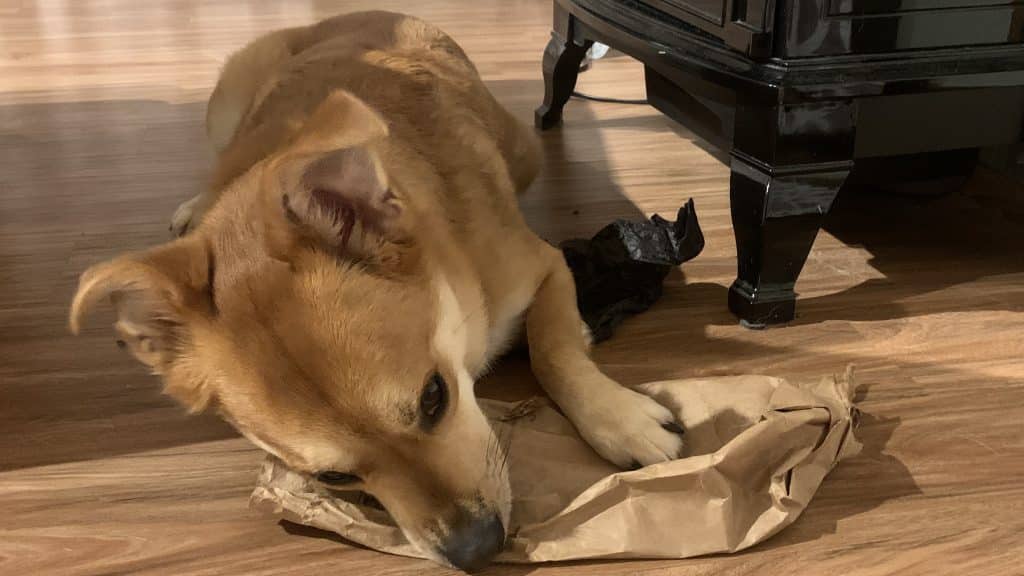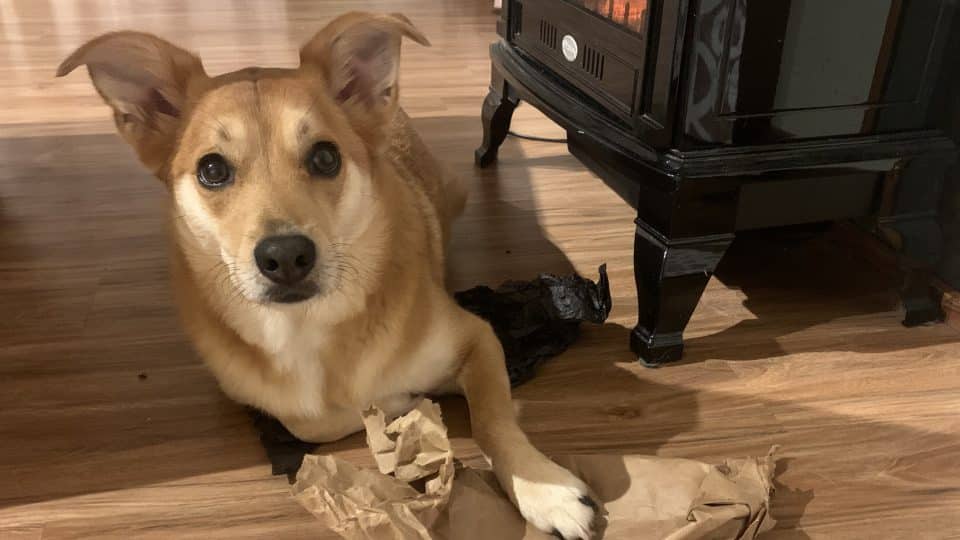- This article has been reviewed by a pet health professional. It is not a substitute for professional veterinary advice.
Do you have a dog who eats and chews cardboard? Believe it or not, this is normal canine behavior.
Dogs evolved to scavenge for food, and cardboard can be a particularly enticing find. It has a nice chewy feel, similar to rawhide, and makes an appealing sound when chomped. Dogs who eat cardboard instead of just shredding it might also be lured by particular scents and flavors left behind, depending on what the cardboard initially contained.
If you’ve got a serial cardboard eater on your hands, we have some ideas on preventing and managing the behavior. To help us out, we spoke with Dr. Wendy Hauser, a veterinary advisor to ASPCA Pet Health Insurance, to learn more about why dogs eat cardboard in the first place.
Reasons Dogs Eat Cardboard
Dogs eat cardboard for a variety of reasons. Once you know why your dog is doing it, it’s easier to find the right solution. Here are some reasons to consider.
- Age. Dr. Hauser notes that puppies explore their environments with their mouths, which means anything accessible is fair game. They might also like the feel of the texture and shape of different types of cardboard and crave it when they’re teething.
- Boredom. Dogs also eat paper and cardboard when they’re bored. If they don’t have puzzles, toys, or other mental stimulation readily available, they might reach for a toilet paper roll instead.
- Stress and fear. Similarly, dogs who are anxious or scared may shred and eat cardboard as a way to self-soothe. Look for patterns when they start chomping. Is it during a stressful situation like a thunderstorm or a part of their separation anxiety when you leave the home?
- Instincts. Dr. Hauser notes that, from an evolutionary perspective, a dog’s feeding behavior comes from scavenging. So your dog might just think they’ve come across a satisfying, chewable morsel when they find a piece of cardboard in reach.
- Pica. If your dog can’t stop eating non-edible things, they might have pica. While this condition sometimes stems from your pup’s taste preferences, health problems like gastrointestinal disease, parasites, liver disease, hypothyroidism, and Cushing’s Disease can also cause it.
- Conditioned behavior. According to Dr. Hauser, well-meaning pet parents who use cardboard boxes or tubes to play with their dogs might unintentionally be signaling that these items are appropriate to use as chew toys.

SolStock via iStock
Risks of Consuming Cardboard
Dr. Hauser says that, ideally, dogs should only eat real, digestible foods. But if your pup does manage to sneak in a few small bites, they’ll likely be okay. How much they can ingest, however, will depend on your dog (and their size, age, and health). Dr. Hauser cautions that there’s no set “safe” amount across the board.
The biggest risk of a dog consuming too much cardboard is gastrointestinal obstruction, which may require emergency veterinary intervention. Other possible effects include:
- nausea and vomiting
- stomach irritation
- diarrhea
- oral trauma (such as wounds to the tongue or gums or broken teeth)
- irritated throat
- coughing
In rarer cases, poisoning can result if the cardboard has any dangerous substance on the surface—like toxic residue left over from laundry detergent or household cleaners.
Thick, multi-layered cardboard is also harder to chew and digest, and cardboard with ink or glue can cause health concerns if ingested in large quantities.
How To Stop Your Dog from Eating Cardboard
Dr. Hauser says that the best way to keep your dog from eating cardboard is to keep it out of reach. While you train your dog not to eat cardboard, you’ll want to practice good management—which means making sure cardboard isn’t available. Here’s what you can do.
Management tips
- Block off areas. Limit your dog’s access to areas in your home where you store cardboard and paper with pet gates. If your dog can’t access it, they won’t be able to chew or eat it.
- Provide chews. Give your dog plenty of edible chews and chew toys. Talk to your vet about good options for safe chewing, especially if your dog has digestion issues.
- Provide safe shredding alternatives. For pups that love to shred and then eat cardboard and paper, try giving them a safe, edible alternative. Lettuce, green beans, and celery are all dog-friendly veggies that have a fun, tasty texture to dissect and eat.
- Use bitter sprays. These sprays taste unpleasant to some dogs (not all!) and may deter them from eating cardboard, though limiting their access to cardboard is a better bet.
- Supervise. If your dog has to be in a space where there’s cardboard, watch closely to ensure they don’t sneak a bite.
- Try supplements. Your vet may recommend certain vitamins or supplements to help quell cravings if they determine your pup’s cardboard obsession is health-related. For example, a vet may recommend zinc, iron, or fiber to help dogs with pica. As always, ask your vet before starting any new diet or supplement routine.
Once you’ve implemented management techniques, you can start training your pup to leave cardboard alone. Here’s how.
Training ideas
- Teach a “leave it” cue. Training your dog to leave things alone can be an incredibly useful and life-saving skill. To teach a “leave it” cue, start off with lower-value objects before moving on to more prized possessions, like cardboard and paper.
- Redirect and trade. If your dog has already gotten ahold of some cardboard, offer them a worthy trade, like a high-value treat, chew, or toy. Once you’ve done this a few times, you can put the action on cue, calling it a “trade,” “swap,” or whatever you’d like.
- Put spitting things out on cue. From a trade, you can gradually reduce the lure and wait for your dog to drop the piece of cardboard. From there, you can start building a “drop it” cue or an emergency “yuck” for when your dog has things in their mouth that could hurt them.

Image via Elizabeth Holbrook
Is It Okay To Let My Dog Play with Cardboard?
For dogs that shred and don’t consume, it may be okay for them to play with cardboard under close supervision. This is a risk assessment you might make with the help of your vet or trainer.
If you’re concerned your dog has ingested cardboard, Dr. Hauser recommends contacting your vet. Signs of obstruction and poisoning include the following:
- Repeated vomiting
- Abdominal distention (a “potbelly” look)
- Constipation
- Diarrhea
- Depression
- Decreased appetite or loss of appetite
- Coughing or retching
- Hiding or not interacting with the family
If your dog has a tendency to consume cardboard, Dr. Hauser advises not using it for any type of interactive play, since it can send mixed messages. For example, training your dog to “leave it” but then introducing a cardboard box as a toy is likely to lead to confusion.
Instead, she recommends swapping out cardboard for other enrichment options, like puzzle toys, KONGs, and chew toys for safe and happy chomping.



